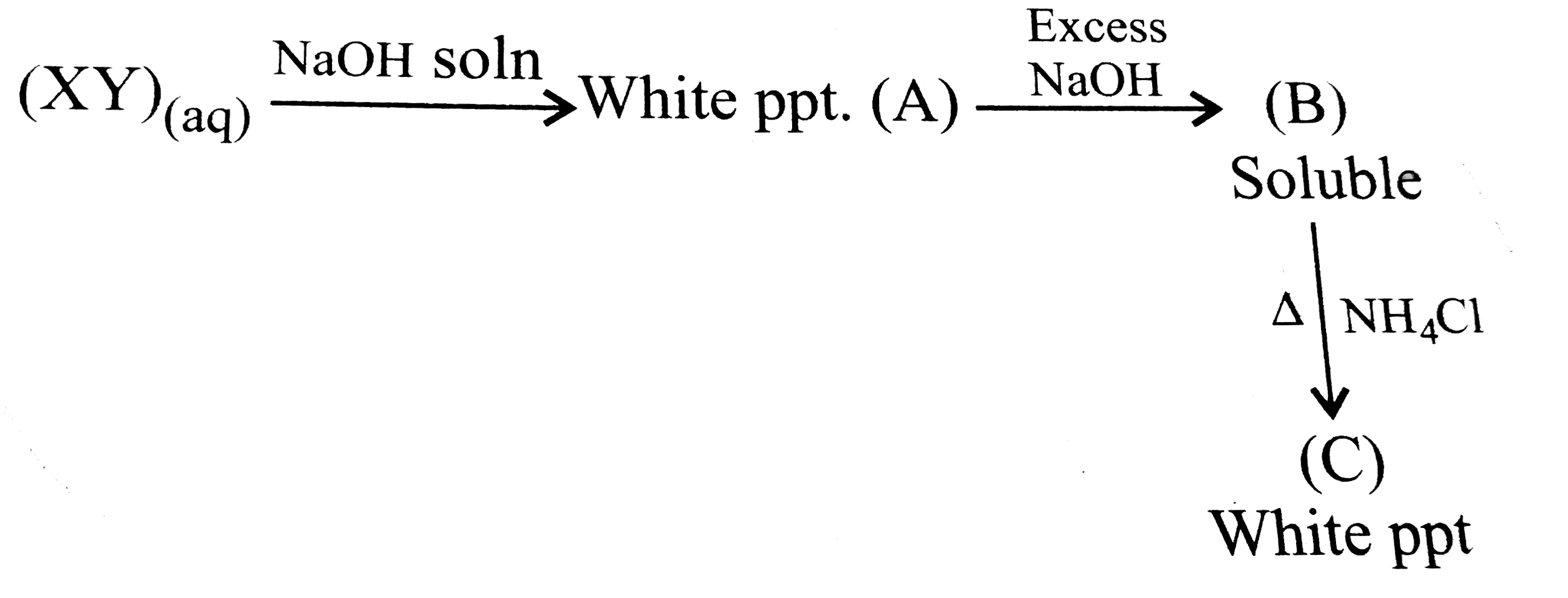The metallic salt (XY) is soluble in water.
(a) When the aqueous soluble of (XY) is treated with NaOH solution, a white precipitate (A) is formed. In excess of NaOH solution, a white precipitate (A) is formed. In excess of NaOH solution, white precipitate (A) dissolves to form a compound (B). When this solution is boiled with soild NH4Cl, a precipitate of compound (C) is formed.
(b) An aqueous solution on treatment with BaCl2 solution gives a white precipitate (D) white is insoluble in conc HCl.
( c) The metallic salt (XY) forms a double salt (E) with potassium sulphate.
Identify (XY),(A),(B),(C),(D) and (E).
(a) 
(X)isAl3+ion
Al3+(aq)+3NaOH(aq)→(Al(OH)3)⏐⏐↓3Na⊕White ppt.(A)
Al(OH)3+NaOH(aq)ExcessHeat−−→NaAlO2(B)Sodium meta-aluminate+2H2O
NaAlO2+NH4Cl+H2OHeat−−→Al(OH)3⏐↓(C)Aluminiumhydroxide+NaCl+NH3
The metallic salt (XY) on treatment with NaOH solution, gives a while precipitate of aluminium hydroxide, Al(OH)3.Al(OH)3 dissolves in excess of NaOH solution forming sodium metaluminate, NaAlO2.NaAlO2 on boiling with NH4Cl solution gives with precipitate of aluminium hydroxide, Al(OH)3.
(b) (XY)(aq)BaCl_(2) solution−−−−−−−−−→(D)White ppt.conc HCl−−−−→(D)Insoluble
(Y) is SO2−4 ion.
So2−4(aq)+Ba2+(aq)→BaSO4↓White ppt.
(D) is barium sulphate, BaSO4, which is insoluble in conc HCl.
Hence, the salt (XY) is Al2(SO4)3, aluminium sulphate.
( c) The double salt (E) formed by (XY) with potassium sulphate is K2SO4.Al2(SO4)3.24H2O i.e. potash alum.
Hence, (XY) is Al2(SO4)3,(A) is Al(OH)3,(B) is NaAlO2,(C) is Al(OH)3,(D) is BaSO4 and (E) is K2SO4.Al2(SO4)3.24H2O.
Topper's Solved these Questions
- P-BLOCK GROUP 13 - BORON FAMILYBook:CENGAGE CHEMISTRYChapter:P-BLOCK GROUP 13 - BORON FAMILYExercise:Ex 6.1 (Subjective)
Explore 17 Videos
- P-BLOCK GROUP 13 - BORON FAMILYBook:CENGAGE CHEMISTRYChapter:P-BLOCK GROUP 13 - BORON FAMILYExercise:Ex 6.1 (Objective)
Explore 14 Videos
- P-BLOCK GROUP 13 - BORON FAMILYBook:CENGAGE CHEMISTRYChapter:P-BLOCK GROUP 13 - BORON FAMILYExercise:Exercise Archives (Subjecive)
Explore 9 Videos
- ORGANIC REACTION MECHANISMBook:CENGAGE CHEMISTRYChapter:ORGANIC REACTION MECHANISMExercise:Analytical and Descriptive
Explore 6 Videos
- P-BLOCK GROUP 14 - CARBON FAMILYBook:CENGAGE CHEMISTRYChapter:P-BLOCK GROUP 14 - CARBON FAMILYExercise:Exercises Archives (Subjective)
Explore 9 Videos
Similar Questions
Knowledge Check
Aqueous solution of a salt when treated with AgNO3 solution gives a white precipitate , white dissolves in NH4OH. Radical present in the salt is
ACl−BS2−CI−DAll of themWhen of the following precipitate is soluble in excess of NH3 solution?
AZn2+,Cd2+BHg2+,Ag+CCu2+,Pb2+DMn2+,Ni2+A white precipitate will be formed if we add common salt solution to :
ABa(NO3)2 solutionBKNO3 solutionCAgNO3 solutionDMg(NO3)2 solution
If NaOH is added to an aqueous solution of zinc ions a white precipitate appears and on adding excess of NaOH, the precipitate dissolves. In this solution, zinc exists in the
View SolutionWhen Bauxite is heated with NaOH solution, the water soluble compound formed is
View SolutionAn aqueous solution of an anhydrous white solid A on addition of KCN solution gives a white precipitate B. Addition of excess of KCN to the precipitate dissolves if forming C.
View SolutionIf NaOH is added to an aqueous solution of Zn2+ ions a white precipitate apperars and on adding excess of NaOH, the precipitate dissolves. In this solution Zinc exists in_____
View SolutionA colourless crystalline salt 'X' is soluble in dilute HCl. On adding NaOH solution, it gives a white precipitate which is insoluble in excess of NaoH. 'X' is
View Solution

